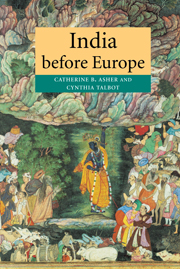Book contents
- Frontmatter
- Contents
- List of illustrations
- List of maps
- Preface
- Glossary
- Place names: alternative spellings
- 1 Introduction: situating India
- 2 The expansion of Turkic power, 1180–1350
- 3 Southern India in the age of Vijayanagara, 1350–1550
- 4 North India between empires: history, society, and culture, 1350–1550
- 5 Sixteenth-century north India: empire reformulated
- 6 Expanding political and economic spheres, 1550–1650
- 7 Elite cultures in seventeenth-century South Asia
- 8 Challenging central authority, 1650–1750
- 9 Changing socio-economic formations, 1650–1750
- Epilogue
- Biographical notes
- Bibliography
- Index
4 - North India between empires: history, society, and culture, 1350–1550
Published online by Cambridge University Press: 05 June 2014
- Frontmatter
- Contents
- List of illustrations
- List of maps
- Preface
- Glossary
- Place names: alternative spellings
- 1 Introduction: situating India
- 2 The expansion of Turkic power, 1180–1350
- 3 Southern India in the age of Vijayanagara, 1350–1550
- 4 North India between empires: history, society, and culture, 1350–1550
- 5 Sixteenth-century north India: empire reformulated
- 6 Expanding political and economic spheres, 1550–1650
- 7 Elite cultures in seventeenth-century South Asia
- 8 Challenging central authority, 1650–1750
- 9 Changing socio-economic formations, 1650–1750
- Epilogue
- Biographical notes
- Bibliography
- Index
Summary
During the fifteenth century a series of regional states developed across north India, some ruled by Muslims and some by Hindus, but in all of them considerable tolerance was shown toward other religions, a fact that most histories overlook. In these independent states what it meant to be culturally sophisticated was increasingly defined not only by parties who subscribed to pan-Indian trends but also by those who promoted distinctly regional vocabularies. The new cultural styles are in part reflected in the production of progressively more substantial architectural projects, both secular and religious, and of illustrated manuscripts and music. The products of the regional kingdoms were more composite in nature, incorporating local cultures with larger Indic and Islamicate ones. In addition, literature in the regional languages began to flourish as never before. Religion too took on new forms in both the Muslim and Hindu traditions, with some movements seeking ways to bypass the traditional ulama in the case of Islam or Brahman priests in the case of Hinduism. Thus, saints and devotees, intense in their emotion for the divine, infused society with an impassioned discourse that was transmitted in literature and religious practice. Although the fifteenth and early sixteenth centuries were a time of political fragmentation and weakness in north India, it was simultaneously an era of considerable cultural innovation.
Regional sultanates
Beginning in the late fourteenth century the now weakened Tughluq dynasty, once spanning much of the Indian subcontinent, began breaking into a series of small regional successor states.
- Type
- Chapter
- Information
- India before Europe , pp. 84 - 114Publisher: Cambridge University PressPrint publication year: 2006
- 1
- Cited by



